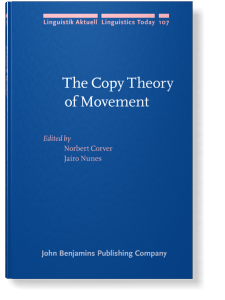The Copy Theory of Movement
Editors
This volume brings together papers which address issues regarding the copy theory of movement. According to this theory, a trace is a copy of the moved element that is deleted in the phonological component but is available for interpretation at L(ogical) F(orm). Thus far, the bulk of the research on the copy theory has mainly focused on interpretation issues at LF. The consequences of the copy theory for syntactic computation per se and for the syntax–phonology mapping, in particular, have received much less attention in the literature, despite its crucial relevance for the whole architecture of the model. As a contribution to fill this gap, this volume congregates recent work that deals with empirical and conceptual consequences of the copy theory of movement for the inner working of syntactic computations within the Minimalist Program, with special emphasis on the syntax–phonology mapping.
[Linguistik Aktuell/Linguistics Today, 107] 2007. vi, 388 pp.
Publishing status: Available
© John Benjamins Publishing Company
Table of Contents
-
From trace theory to copy theoryNorbert Corver and Jairo Nunes | pp. 1–9
-
Part I. The copy theory of movement on the PF-side
-
The copy theory of movement: A view from PFŽeljko Bošković and Jairo Nunes | pp. 13–74
-
Part II. On multiple realization of copies
-
Double realization of verbal copies in European Portuguese emphatic affirmationAna Maria Martins | pp. 77–118
-
On fusion and multiple copy spell-out: The case of verbal repetitionJason Kandybowicz | pp. 119–150
-
Verb copying in Mandarin ChineseLisa Lai-Shen Cheng | pp. 151–174
-
Dutch 's-prolepsis as a copying phenomenonNorbert Corver | pp. 175–216
-
Part III. On lower copy realization
-
Free word order and copy theory of movementSandra Stjepanović | pp. 219–248
-
Variable pronunciation sites and types of wh-in-situChris H. Reintges | pp. 249–287
-
Part IV. Further issues: Cyclicity, accessibility and unavailability of copying
-
Cyclic chain reductionTomohiro Fujii | pp. 291–326
-
Agreement with (the internal structure of) copies of movementMarjo van Koppen | pp. 327–350
-
Pronouns in a Minimalist SettingNorbert Hornstein | pp. 351–385
-
Index | pp. 387–388
“"If I look at the sky and see two identical airplanes, one following the other at a certain distance, my common sense, my cognitive make-up and my experience tell me that, putting aside the possibility of an optical illusion, I am indeed facing two distinct, albeit similar airplanes, rather than two instantiations of the same airplane occupying different chunks of space. One of the intriguing aspects of the copy theory of traces, especially as developed in this book, is that this basic informal principle of perception does not apply in the realm of language: under certain circumstances, the same linguistic object may occupy (be pronounced/perceived/interpreted) in two different sentential positions. There appears to be an analogue in the domain of general relativity theory: in the vicinity of an extremely massive body such as a black hole, the light emanating, say, from a star, may be bent in such a way that it goes through two distinct, opposite sides of the hole. Appropriately positioned, we might thus be able to see two instantiations of the same star. If the copy theory is correct, it will confirm in an intriguing way the fact that language has "properties that appear to be unusual in the biological world" (Chomsky, The Minimalist Program) but are instead rather close to those of physical systems of some complexity."”
Eduardo Raposo, University of California at Santa Barbara
“"Few ideas have gained such a central importance in modern linguistics as syntactic movement. This special property of human languages - which is in some way implemented in all theoretical models - is now at the very center of the debate within the Minimalist Programme for its major consequences on the general architecture of the language faculty. Norbert Corver and Jairo Nunes's anthology focus on the nature of this phenomenon providing strong original evidence in favour of the so-called "copy theory of movement" which constitutes one of the most innovative ideas of the Miminalist Programme itself. An unvaluable source of data and a thought-provoking challenge to any future research in the field."”
Andrea Moro,
Università San Raffaele, Milan
Cited by (43)
Cited by 43 other publications
AN, DUK-HO
Isac, Daniela
Silva Garcés, José & Gonzalo Espinosa
Aptacy, Jarosław
Duguine, Maia
Gärtner, Hans-Martin
Villa-García, Julio & Hugo Sánchez-Llana
2022. Chapter 2. Asturian and Asturian Spanish at the syntax-phonology interface. In Sound, Syntax and Contact in the Languages of Asturias [Issues in Hispanic and Lusophone Linguistics, 36], ► pp. 15 ff. 
Al-Raba'a, Basem Ibrahim Malawi
Badan, Linda & Claudia Crocco
Lee, Tommy Tsz-Ming
Wang, Changsong
2021. Asymmetries in two types ofde-related verb-copying constructionsin Mandarin Chinese. International Journal of Chinese Linguistics 8:2 ► pp. 241 ff. 
Lam, Charles
Villa-García, Julio
Camacho, José
Corver, Norbert
Krivochen, Diego Gabriel
Cheng, Lisa Lai-Shen & Luis Vicente
Abe, Jun & Norbert Hornstein
Biberauer, Theresa & Michelle Sheehan
Bošković, Željko
Bury, Dirk & Hiroyuki Uchida
Citko, Barbara
Epstein, Samuel David, Hisatsugu Kitahara & T. Daniel Seely
Fábregas, Antonio
Gračanin‐Yuksek, Martina
Lahne, Antje
Lechner, Winfried
Miyamoto, Yoichi
Nunes, Jairo
Nunes, Jairo
2014. Adjunct Control and edge features. In Minimalism and Beyond [Language Faculty and Beyond, 11], ► pp. 79 ff. 
Nunes, Jairo
Obata, Miki & Samuel David Epstein
[no author supplied]
This list is based on CrossRef data as of 18 july 2024. Please note that it may not be complete. Sources presented here have been supplied by the respective publishers. Any errors therein should be reported to them.
Subjects
Main BIC Subject
CFK: Grammar, syntax
Main BISAC Subject
LAN009000: LANGUAGE ARTS & DISCIPLINES / Linguistics / General
